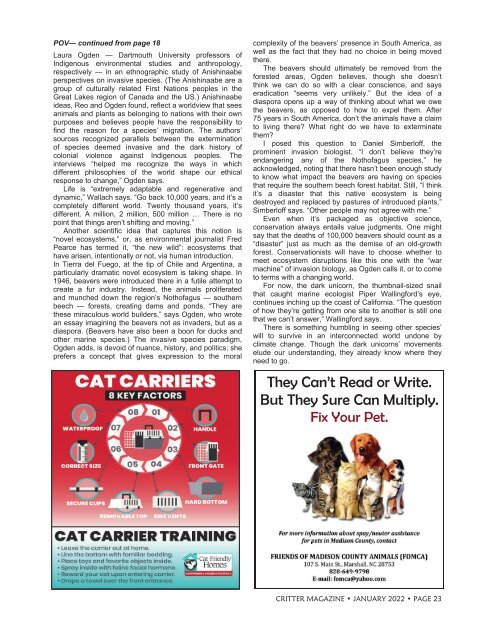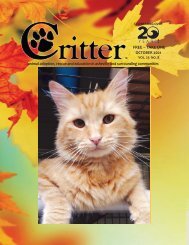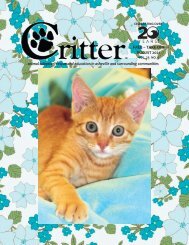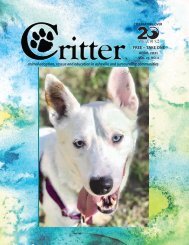Create successful ePaper yourself
Turn your PDF publications into a flip-book with our unique Google optimized e-Paper software.
POV— continued from page 18<br />
Laura Ogden — Dartmouth University professors of<br />
Indigenous environmental studies and anthropology,<br />
respectively — in an ethnographic study of Anishinaabe<br />
perspectives on invasive species. (The Anishinaabe are a<br />
group of culturally related First Nations peoples in the<br />
Great Lakes region of Canada and the US.) Anishinaabe<br />
ideas, Reo and Ogden found, reflect a worldview that sees<br />
animals and plants as belonging to nations with their own<br />
purposes and believes people have the responsibility to<br />
find the reason for a species’ migration. The authors’<br />
sources recognized parallels between the extermination<br />
of species deemed invasive and the dark history of<br />
colonial violence against Indigenous peoples. The<br />
interviews “helped me recognize the ways in which<br />
different philosophies of the world shape our ethical<br />
response to change,” Ogden says.<br />
Life is “extremely adaptable and regenerative and<br />
dynamic,” Wallach says. “Go back 10,000 years, and it’s a<br />
completely different world. Twenty thousand years, it’s<br />
different. A million, 2 million, 500 million … There is no<br />
point that things aren’t shifting and moving.”<br />
Another scientific idea that captures this notion is<br />
“novel ecosystems,” or, as environmental journalist Fred<br />
Pearce has termed it, “the new wild”: ecosystems that<br />
have arisen, intentionally or not, via human introduction.<br />
In Tierra del Fuego, at the tip of Chile and Argentina, a<br />
particularly dramatic novel ecosystem is taking shape. In<br />
1946, beavers were introduced there in a futile attempt to<br />
create a fur industry. Instead, the animals proliferated<br />
and munched down the region’s Nothofagus — southern<br />
beech — forests, creating dams and ponds. “They are<br />
these miraculous world builders,” says Ogden, who wrote<br />
an essay imagining the beavers not as invaders, but as a<br />
diaspora. (Beavers have also been a boon for ducks and<br />
other marine species.) The invasive species paradigm,<br />
Ogden adds, is devoid of nuance, history, and politics; she<br />
prefers a concept that gives expression to the moral<br />
complexity of the beavers’ presence in South America, as<br />
well as the fact that they had no choice in being moved<br />
there.<br />
The beavers should ultimately be removed from the<br />
forested areas, Ogden believes, though she doesn’t<br />
think we can do so with a clear conscience, and says<br />
eradication “seems very unlikely.” But the idea of a<br />
diaspora opens up a way of thinking about what we owe<br />
the beavers, as opposed to how to expel them. After<br />
75 years in South America, don’t the animals have a claim<br />
to living there? What right do we have to exterminate<br />
them?<br />
I posed this question to Daniel Simberloff, the<br />
prominent invasion biologist. “I don’t believe they’re<br />
endangering any of the Nothofagus species,” he<br />
acknowledged, noting that there hasn’t been enough study<br />
to know what impact the beavers are having on species<br />
that require the southern beech forest habitat. Still, “I think<br />
it’s a disaster that this native ecosystem is being<br />
destroyed and replaced by pastures of introduced plants,”<br />
Simberloff says. “Other people may not agree with me.”<br />
Even when it’s packaged as objective science,<br />
conservation always entails value judgments. One might<br />
say that the deaths of 100,000 beavers should count as a<br />
“disaster” just as much as the demise of an old-growth<br />
forest. Conservationists will have to choose whether to<br />
meet ecosystem disruptions like this one with the “war<br />
machine” of invasion biology, as Ogden calls it, or to come<br />
to terms with a changing world.<br />
For now, the dark unicorn, the thumbnail-sized snail<br />
that caught marine ecologist Piper Wallingford’s eye,<br />
continues inching up the coast of California. “The question<br />
of how they’re getting from one site to another is still one<br />
that we can’t answer,” Wallingford says.<br />
There is something humbling in seeing other species’<br />
will to survive in an interconnected world undone by<br />
climate change. Though the dark unicorns’ movements<br />
elude our understanding, they already know where they<br />
need to go.<br />
They Can’t Read or Write.<br />
But They Sure Can Multiply.<br />
Fix Your Pet.<br />
CRITTER MAGAZINE • JANUARY 2022 • PAGE 23
















